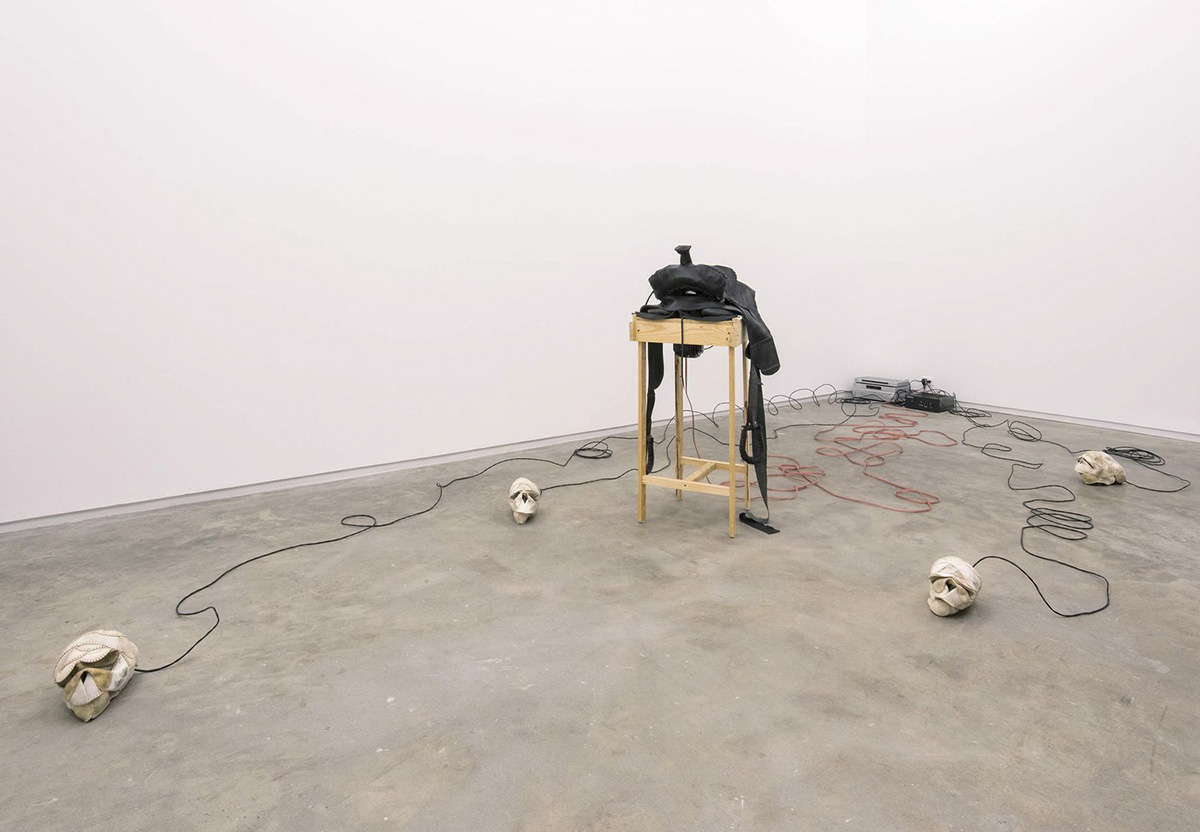Art exhibit review: ‘The Evening Redness in the West’ evokes often overlooked Indigenous history

(Courtesy of Catriona Jeffries)
“The Evening Redness in the West”
Brian Jungen
The Hammer Museum
Aug. 14 to Oct. 31
By David Egan
Aug. 17, 2021 2:01 p.m.
This post was updated Aug. 22 at 7:02 p.m.
The saddle in Brian Jungen’s “The Evening Redness in the West” is tempting viewers to mount its leather seat.
Placed on a wooden plinth, the saddle is front and center at the Hammer Museum’s latest exhibit, surrounded by skulls and fidgeting with the sonic vibrations of Hollywood Westerns. The setup could have been self-indulgently edgy – empty saddle, unidentified ’90s film – but Jungen redeems the exhibit with his skilled craftsmanship and the saddle’s rousing, spastic movements.
The exhibit’s strength is its juggling of history and contemporary life – the former marked by the oppression of Indigenous cultures such as the Canadian Jungen’s Doig River band of Dane-zaa Nation and the latter by dizzying cycles of progress and setback. But a more emphatic execution would have made the exhibit’s themes as conspicuous as Jungen’s technical skill and artistic sensibility.
Jungen’s display is about the Native American experience, but one might not deduce this by simply looking at the work. Without context from the Hammer’s description, which states that the exhibit questions the representation of Native American experience in popular culture, the sculptural and auditory elements would be at most intriguing and well-designed.
On Saturday, viewers seemed to stay in the exhibit’s room for about five minutes. But longer contemplation of the Western scene can evoke the Indigenous history overlooked in American culture. This exhibit depicts that negligence with its empty saddle and disembodied voices and mourns it with harrowing, anonymous skulls.
[Related: ‘For the Love of L.A.’ exhibit showcases local artists, reflects on social issues]
Jungen sews the present into the past, constructing historical objects – the saddle and skulls – with contemporary American materials. In an interview with Tate Modern, Jungen stated that when his family members acquired money, they would first buy affordable leather furniture, sparking his interest in the conceptually thought-provoking use of American consumer goods.
The saddle, constructed of leather from a vibrating chair made for a home entertainment system, looms in the middle of the space above the four skulls, which are made from baseball and softball leather. There are no loose threads or frays in the expertly sewn objects, a relief within the disorienting space of a contemporary art exhibit.
When “The Evening Redness in the West” asserts emotional force, it does so instantaneously, as the saddle-holding plinth scrapes the floor, vibrating with the booms, bass and gunshots of the film’s audio. Though it happens sporadically, when the plinth moves, it startles. The saddle and its invisible rider become threatening, the skulls on the floor unsettling.
[Related: ‘Re: Model’ digital gallery showcases creative works from AAPI students]
Like art in the Revisionist Western genre, including Quentin Tarantino’s “Django Unchained” and Cormac McCarthy’s 1985 novel “Blood Meridian” – the subtitle of which gave the exhibit its name – “The Evening Redness in the West” is subtly sardonic in its portrayal of the past. Revisionist Westerns subvert the traditional Western story, exposing and critiquing the senseless violence and machismo of 19th century America through an extreme, sometimes ironic depiction of it. Jungen seems tongue-in-cheek in his materials and matter-of-fact decision to play Western films’ audio from start to finish, contributing to the cool contemporary aesthetic but further complicating the exhibit’s thesis.
The cowboy movies’ audio, or at least the 1992 film “Tombstone” which played Saturday, sounds banal and cartoonish, undermining expectations of horror or glamor. One hears men stoner-philosophizing under the cosmos, carnival and bar scenes and romantic encounters.
In a classic Western, violence of the past is packaged into consumable entertainment. In the same way, Jungen wraps the saddle, a symbol of masculine conquest, with the skin of an object of passive consumption. The saddle, shaking with the noise of gunshots, sounds bashfully of flatulence, an interpretation that might be influenced by the knowledge that the leather once covered a symbol of sedentary lifestyles, a chair for the glazed-eyed and gaseous.
Jungen’s method aside, the exhibit has sincere intentions – in broad terms to reckon with the past and present through aesthetics. The artist’s skillful craftsmanship and ironic detachment achieve this, even though a discernible message is at first hard to find. While frustrating, the mystique may be a feature rather than a bug. The saddle tempts viewers to mount and make peace with history, and a spasm may shift it to face a viewer head-on.
But Western gunshots ward off riders, not to mention four skulls and the gallery’s tripwire.


